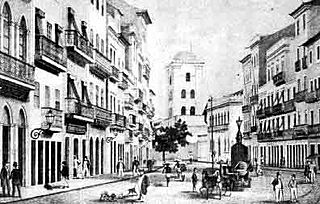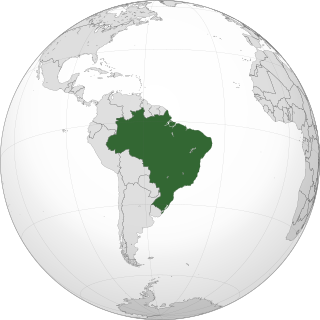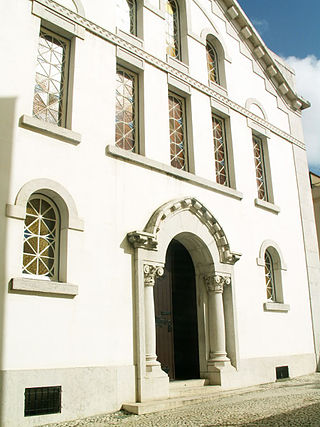
Recife is the fourth-largest urban area in Brazil with 4,054,866 inhabitants, the largest urban area of the North/Northeast Regions, and the capital and largest city of the state of Pernambuco in the northeast corner of South America. The city has more than a thousand shootings per year, making it one of the most violent in Brazil.The population of the city proper was 1,653,461 in 2020. Recife was founded in 1537, during the early Portuguese colonization of Brazil, as the main harbor of the Captaincy of Pernambuco, known for its large scale production of sugar cane. It was the former capital Mauritsstad of the 17th century colony of New Holland of Dutch Brazil, established by the Dutch West India Company. The city is located at the confluence of the Beberibe and Capibaribe rivers before they flow into the South Atlantic Ocean. It is a major port on the Atlantic. Its name is an allusion to the stone reefs that are present by the city's shores. The many rivers, small islands and over 50 bridges found in Recife city centre characterise its geography and led to the city being called the "Brazilian Venice". As of 2010, it is the capital city with the highest HDI in Northeast Brazil and second highest HDI in the entire North and Northeast Brazil.

SephardicJews, also known as Sephardi Jews or Sephardim, and rarely as Iberian Peninsular Jews, are a Jewish diaspora population associated with the Iberian Peninsula. The term, which is derived from the Hebrew Sepharad, can also refer to the Jews of the Middle East and North Africa, who were also heavily influenced by Sephardic law and customs. Many Iberian Jewish exiled families also later sought refuge in those Jewish communities, resulting in ethnic and cultural integration with those communities over the span of many centuries.

Recife Antigo is the historical section of central Recife, Brazil. It is located on the Island of Recife, near the Recife harbor. This historic area has been recently recovered and now holds several clubs, bars and a high-tech center called Porto Digital.

Paradesi Jews immigrated to the Indian subcontinent during the 15th and 16th centuries following the expulsion of Jews from Spain. Paradesi refers to the Malayalam word that means foreign as they were newcomers. These Sephardic immigrants fled persecution and death by burning in the wake of the 1492 Alhambra decree expelling all Jews who did not convert to Christianity from Spain and King Manuel's 1496 decree expelling Jews from Portugal. They are sometimes referred to as "White Jews", although that usage is generally considered pejorative or discriminatory and refers to relatively recent Jewish immigrants, predominantly Sephardim.
Spanish and Portuguese Jews, also called Western Sephardim, Iberian Jews, or Peninsular Jews, are a distinctive sub-group of Sephardic Jews who are largely descended from Jews who lived as New Christians in the Iberian Peninsula during the few centuries following the forced expulsion of unconverted Jews from Spain in 1492 and from Portugal in 1497. They should therefore be distinguished both from the descendants of those expelled in 1492 and from the present-day Jewish communities of Spain and Portugal.

The history of the Jews in Portugal reaches back over two thousand years and is directly related to Sephardi history, a Jewish ethnic division that represents communities that originated in the Iberian Peninsula. In the sixteenth and seventeenth centuries, Portuguese Jews emigrated to a number of European cities outside Portugal, where they established new Portuguese Jewish communities, including in Hamburg, Antwerp, and the Netherlands, which remained connected culturally and economically, in an international commercial network during the seventeenth and eighteenth centuries.

The community of Sephardic Jews in the Netherlands, particularly in Amsterdam, was of major importance in the seventeenth century. The Portuguese Jews in the Netherlands did not refer to themselves as "Sephardim", but rather as "Hebrews of the Portuguese Nation." The Portuguese-speaking community grew from conversos, Jews forced to convert to Catholicism in Spain and Portugal, who rejudaized under rabbinical authority, to create an openly self-identified Portuguese Jewish community. As a result of the expulsions from Spain in 1492 and Portugal in 1496, as well as the religious persecution by the Inquisition that followed, many Spanish and Portuguese Jews left the Iberian peninsula at the end of the 15th century and throughout the 16th century, in search of religious freedom. Some migrated to the newly independent Dutch provinces which allowed Jews to become residents. Many Jews who left for the Dutch provinces were crypto-Jews. Others had been sincere New Christians, who, despite their conversion, were targeted by Old Christians as suspect. Some of these sought to return to the religion of their ancestors. Ashkenazi Jews began migrating to the Netherlands in the mid-seventeenth century, but Portuguese Jews viewed them with ambivalence.

Dutch Brazil, also known as New Holland, was a colony of the Dutch Republic in the northeastern portion of modern-day Brazil, controlled from 1630 to 1654 during Dutch colonization of the Americas. The main cities of the colony were the capital Mauritsstad, Frederikstadt, Nieuw Amsterdam (Natal), Saint Louis, São Cristóvão, Fort Schoonenborch (Fortaleza), Sirinhaém, and Olinda.

Isaac Aboab da Fonseca was a rabbi, scholar, kabbalist, and religious writer. In 1656, he was one of several elders within the Portuguese-Jewish community in Amsterdam and for a time in Dutch Brazil before the Portuguese reconquest. He was one of the religious leaders who excommunicated philosopher Baruch Spinoza in 1656.
Moses Cohen Henriques was a Dutch pirate of Portuguese Sephardic Jewish origin. Operating in the Caribbean, the total haul of his raids on the Spanish is estimated to be about 1 billion USD in today's value.

The Portuguese Synagogue, also known as the Esnoga, or Snoge, is a late 17th-century Sephardic synagogue in Amsterdam, completed in 1675. Esnoga is the word for synagogue in Judaeo-Spanish, the traditional Judaeo-Spanish language of Sephardi Jews.

The history of the Jews in Brazil begins during the settlement of Europeans in the new world. Although only baptized Christians were subject to the Inquisition, Jews started settling in Brazil when the Inquisition reached Portugal, in the 16th century. They arrived in Brazil during the period of Dutch rule, setting up in Recife the first synagogue in the Americas, the Kahal Zur Israel Synagogue, as early as 1636. Most of those Jews were Sephardic Jews who had fled the Inquisition in Spain and Portugal to the religious freedom of the Netherlands.
Amazonian Jews are the Jews of the Amazon basin, mainly descendants of Moroccan Jews who migrated to northern Brazil and Peru in the 19th and early 20th centuries. The migrants were attracted to the growing trade in the Amazon region, especially during the rubber boom, as well as to the newly established religious tolerance. They settled in localities along the Amazon River, such as Belém, Cametá, Santarém, Óbidos, Parintins, Itacoatiara and Manaus in Brazil, some venturing as far as Iquitos in Peru.
The history of the Jews in Jamaica predominantly dates back to migrants from Spain and Portugal. Starting in 1509, many Jews began fleeing from Spain because of the persecution of the Holy Inquisition. When the English captured Jamaica from Spain in 1655, the Jews who were living as conversos began to practice Judaism openly. By 1611, the Island of Jamaica had reached an estimated population of 1,500 people. An estimated 75 of those people were described as "foreigners," which may have included some Portuguese Jews. Still, many Jews faced persecution from English merchants.

Dutch Brazilians refers to Brazilians of full or partial Dutch ancestry. Dutch Brazilians are mainly descendants of immigrants from the Netherlands.

The Lisbon Synagogue is a historical synagogue situated in the civil parish of Santo António, in the municipality of Lisbon, Portugal.

The Kadoorie Mekor Haim Synagogue is a synagogue of the Jewish community of Porto, situated in the civil parish of Lordelo do Ouro e Massarelos, the municipality of Porto, in the Portuguese northern district of Porto. Constructed along the Rua Guerra Junqueiro beginning in 1929 and inaugurated in 1938, it is the largest synagogue in the Iberian Peninsula.
Josiah ben David Pardo (1626-1684) was a Dutch rabbi and hakham, who served as a Rabbi in Willemstad, Curaçao and in Port Royal, Jamaica. Josiah Pardo was one of the first rabbis who settled in the New World and a pioneer of many Jewish communal and educational institutions in the Western Hemisphere.

Brazil—Netherlands relations refers to the bilateral relationship between Brazil and the Netherlands. Brazil has an embassy in The Hague and a consulate in Amsterdam, and the Netherlands is represented by an embassy in Brasília and consulates in Belém, Belo Horizonte, Curitiba, Fortaleza, Manaus, Natal, Porto Alegre, Recife, Salvador, Rio de Janeiro, Santos, São Paulo and Vila Velha.















